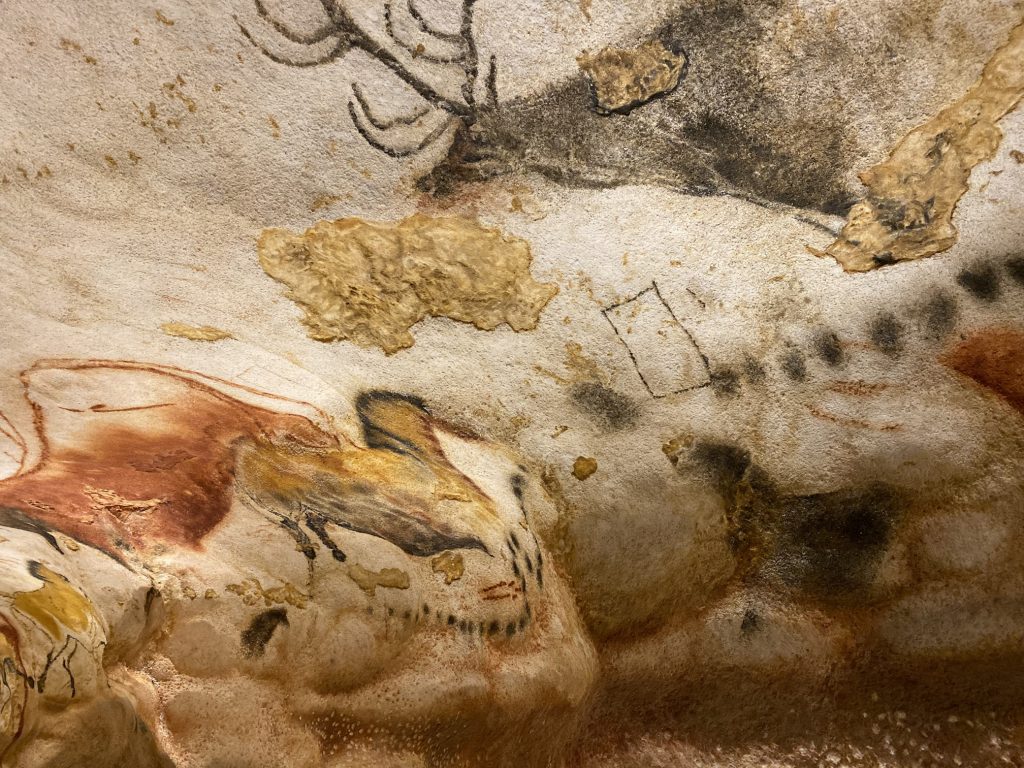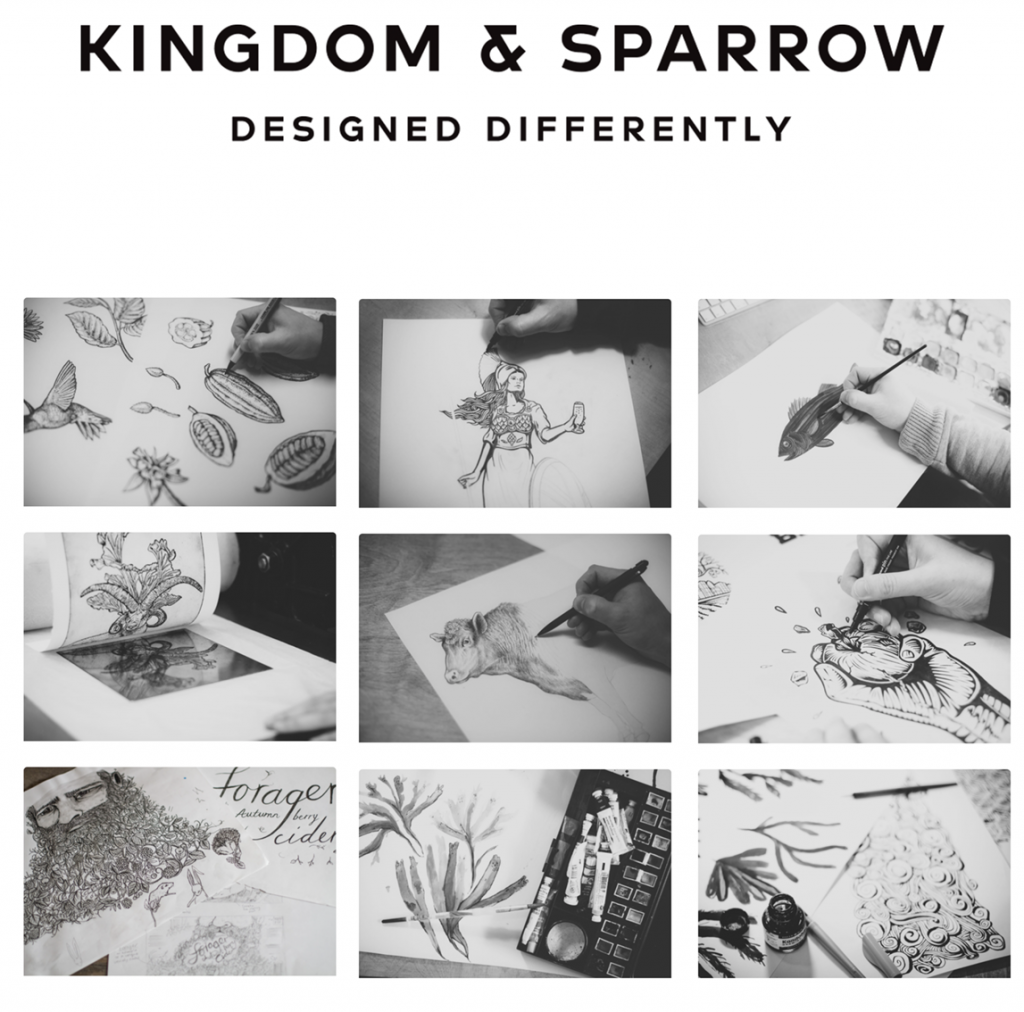Guest lecture with Susanna Edwards and Maziar Raein
Roberts, L., (2005) Drip Dry Shirts: The Evolution of the Graphic Designer
This week we looked at the history of design as well as being encouraged to examine our own locations and the design practices, production industries and inspiring work surrounding us. This has been a bit more difficult to do during a global pandemic, but it has enabled me to connect with resources I had not know were available and expand my reach.
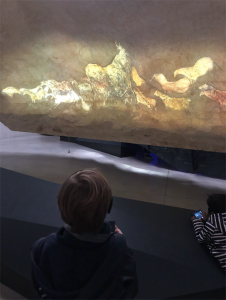
The history of design is what resonated with me the most this week. Last year I visited the site of the famous cave paintings in Lascaux, France, with my family.![]() The visitors centre is a well thought out experience, the actual caves are too delicate to visit so they have recreated the cave system and built an interactive exhibit. I watched my youngest son navigate the exhibits using a tablet that brought the cave painting to life, explained the history of the site and its discovery and harness technology to communicate in ways the cave painters could never have imagined. Despite the huge difference in time and technology, the exhibits and the paintings were both communicating in the same way, art and design transcend barriers and fill a deep human need to connect and understand one another.
The visitors centre is a well thought out experience, the actual caves are too delicate to visit so they have recreated the cave system and built an interactive exhibit. I watched my youngest son navigate the exhibits using a tablet that brought the cave painting to life, explained the history of the site and its discovery and harness technology to communicate in ways the cave painters could never have imagined. Despite the huge difference in time and technology, the exhibits and the paintings were both communicating in the same way, art and design transcend barriers and fill a deep human need to connect and understand one another.
From my reading and research I started following a thread through history. Cave paintings led to written language and alphabets. The invention of paper and printing techniques led to mass production and advertising. Moveable type and the printing press led to a huge explosion of ideas and education throughout the world. There is a clear line linking the history of typography, print production, commercial art, and more modern graphic design.
Design, for me, is the intersection of art and craft. It is both, and encompasses so many specialisations. We live in a transitional time, technology is always evolving, which mean constant change and new possibilities. Design has gone from very precise, delineated crafts, with a traditional apprenticeship systems and rigid boundaries, into something more accessible. This has enabled the lines of design and craft and art to further blur. You no longer need to apprentice to an engraver or printer to work with typography, we no longer cut and paste with actual scissors and glue unless that is a conscious choice in our work. Layout, photography, illustration, and typography are now fluid. Technological advances are always a two edged sword, however – “As is always the case, new techniques open the way for experimentation and change. … Sadly, these technological changes led to the almost total disappearance of skilled engravers – craftsmen who had learnt within the trade.” (Roberts, 2005). Many positions that would have been needed to keep a design studio running in the past have been lost. Some of these changes are positive, leading to more agile workflows and removing time consuming and oftentimes dangerous tasks, but we have also lost some of the traditional skills and techniques that had value.
The invention of the “undo” button itself has saved so many hours of work and the ability to move every element of a design infinite times has led to many happy design accidents. The digital revolution that opened design up has now led to an overload, with so many options that you have specialised, delineated jobs again. Do I do print design, motion graphics, branding and identity, web design, app design, UX/UI, visual design or many more options? What software do I specialise in? What about traditional techniques? Does my role overlap with programming or with visual art? Am I production based or theoretical? Am I insular or collaborative? How can I learn and expand my worldview? This brings me back to my takeaway from last week – design is about how I view the world and a way of thinking and making choices. I don’t have to label myself as a specific type of designer, I can be open to change and growth and let new ideas inform my practice.
Every technological evolution has led to further expression and freedom of that expression. We have the opportunity to engage with design on a world-wide level in a way that has never been possible before. I enjoyed Edwards and Raein’s discussion about micro-utopias. “Millennials who are very much, in the English press anyway, are very much being blamed for looking at their phones. But what they are actually doing is that they are searching for things that have meaning for them and trying to communicate that through objects, through their appreciation of the world they live in.” (Edwards and Raein, 2020). I would be classed as one of the first Millennials, coming in at the tail end of Generation X in the early 80’s. I’ve lived through a tremendous amount of change and upheaval, but have also experienced the evolution of communication and the power of technology to link people in very concrete ways.
When I first moved to Cornwall in 2003, I would have one very expensive transatlantic phonecall home a week. The line was crackly and full of delays and my family would take turns saying a brief hello. Every iteration of web calls and paid-for technology were duly used through the years. My children now take for granted that they can video chat with family in America every day, with clear picture quality, clear audio, and zero cost. Millennials have recognised the power of technology to forge connections and interact with a broader world.
The idea that design can be used to influence the world around us is very powerful, and very true. Design is communication, and communication ideally leads to education and empathy. Design can inform, inspire and incite change, whether for social, political or human interest. We live in unprecedented times, quarantines and lockdowns have changed the ways businesses work. Necessity is removing barriers and opening industries to new ideas about the nature of work and work spaces, and making conferences and cultural events more accessible than ever.
Week 2 Challenge
Design Practice
Select three practices / businesses you feel summarise your city today, in terms of design practice
Design Production
Select three places for design production in your city
Practice
I live in a small town by the sea in Cornwall, rather than a city. Cornwall has always had a vibrant art and design scene, artists were drawn by the quality of light, beautiful scenery and environment. Once the railroad made Cornwall more accessible, several schools of painting were established, most notably in Newlyn, Lamorna and St Ives. Falmouth University was founded in 1902 as the Falmouth School of Art, and although Cornwall is quite small there is no shortage of design studios to choose from. I approached three with some interview questions.
I started very close to home, with Nixon Design in Hayle, “a creative agency specialising 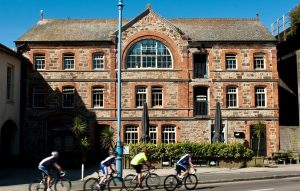 in brand, digital, content and print.” Hayle has a rich historical background, and is a world heritage site for its part in the industrial revolution and the design and manufacturing of the steam engine. The Foundry area where Nixon’s studio is based was home to a pivotal engineering and manufacturing site, Harvey’s Foundry. Nixon are located in the top floor of Whites Warehouse.
in brand, digital, content and print.” Hayle has a rich historical background, and is a world heritage site for its part in the industrial revolution and the design and manufacturing of the steam engine. The Foundry area where Nixon’s studio is based was home to a pivotal engineering and manufacturing site, Harvey’s Foundry. Nixon are located in the top floor of Whites Warehouse.
This is a link to their year in review for 2019, which includes a showreel they made with Lightbox, another great local Cornish company working out of Hayle. Nixon are a traditional studio, who create very polished and professional work.
Insert Q&A here
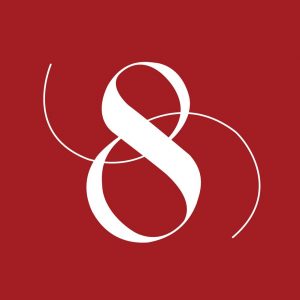 Eight Wire “Eight Wire is a design and marketing agency based in Falmouth, Cornwall. We offer high quality graphic design, web development and marketing solutions to help companies promote themselves in print, web and other media.”
Eight Wire “Eight Wire is a design and marketing agency based in Falmouth, Cornwall. We offer high quality graphic design, web development and marketing solutions to help companies promote themselves in print, web and other media.”
Eight Wire specialise in helping Cornish businesses brand and market themselves. They support small business, and are active in the local community. I emailed with a few questions and they replied with fantastic in-depth answers.
Q. When was Eight Wire founded? Did the university in Falmouth play a part in its conception or bring people together who have worked at Eight Wire?
A.Eight Wire was founded in 2004 and incorporated in February 2012. Sara Pugh, who founded Eight Wire, studied at Falmouth University, qualifying with a Graphic Design BA(Hons). After graduating she spent some time working for a design agency in London. After this she travelled to New Zealand where she made the decision to return to Cornwall to set up her own design company. I am unaware if Falmouth University played a part in conception (this is something I will have to ask Sara). Many people who have worked at Eight Wire and current staff have studied at Falmouth University. The university isn’t part of the employment process at Eight Wire however as many graduates are coming out of Falmouth with the necessary skills, impressive portfolios and the drive and positive attitude to support this, they are highly employable. I think it is also the case that many graduates choose to stay in Cornwall as it’s such a desirable place to live. The location paired with the growing creative scene can be difficult to leave behind!
“A new generation of branding agency for a new generation of brands. Our team combines fresh thinking and imaginative design to elevate and transform the brands of today.”
Kingdom and Sparrow (K&S) are a design agency located in Falmouth. They specialise in branding and packaging and do a lot of work with the food and drink industry. They combine the digital with beautiful hand produced illustrative work, they put an emphasis on traditional techniques and regularly take classes together as a studio. From their website “Our studio just so happens to be the original Falmouth School of Art, built in 1902, and we’re proud to be here keeping traditional techniques alive. From lino-cutting and screen-printing to painting and etching, we get our hands dirty to bring craftsmanship, creativity and originality to the brands we create. ” K&S bring a real sense of history and place into their studio and work. The Cornish influence can be felt, alongside a real love for the craft and artistry of design.
Kingdom and Sparrow were kind enough to answer some questions for me.
Q. When did you establish Kingdom and Sparrow? Are you from Cornwall originally? Did the University play a part in its conception?
A. K&S was founded way back when in 2012! None of the founders are from Cornwall originally although (and this answers the second part) Johnny did Illustration at Falmouth Uni and fell in love with it from there. He then convinced Dan to move down and start the business!
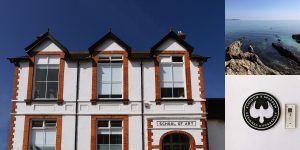 Q. The Old School of Art – from your website I feel like you are really inspired by the location of your studio. Do you feel it gives you a sense of connection to the history of Falmouth? I really love how central traditional technique is to your work!
Q. The Old School of Art – from your website I feel like you are really inspired by the location of your studio. Do you feel it gives you a sense of connection to the history of Falmouth? I really love how central traditional technique is to your work!
A. We are definitely inspired by the Old Art School. When the building came available it was basically a no brainer – we knew we had to make this the K&S home. Throughout the building are all manner of historical reminders, from the plaque commemorating Anna Fox by the front door, to the woodwork embellishments around the place. Although we do utilise a lot of modern techniques, it definitely brings us back to that traditional, handcrafted style that our clients (and us!) love. It also helps that nearly every window has a sea view – there’s nothing quite as inspiring as the Cornish coastline!
Q. Do you share the space with any other businesses? Falmouth is home to quite a few creative industries, does this influence your work as well or lead to creative collaborations?
A. We don’t! We’re lucky enough that over the past year or two our team has grown significantly, and whilst we’ve got plenty of space (social distancing has been a good way to tell this!), we don’t currently have any other businesses occupying it. We haven’t particularly collaborated with anyone locally – although as a company we try to make time (when a global pandemic isn’t happening!) for the whole to team to have an evening class on something (still life, life drawing etc.). We are also very aware of the talent that surrounds us, from working with local photographers, to our directors having locally made bespoke pottery commissioned for the team’s Christmas presents! (SM Ceramics – you should definitely check his stuff out, he’s great. He’s just opening a studio on the high street in fact I think). In terms of collaborating on branding and design work with local creatives, we haven’t actually done anything as yet, but would definitely be up for it if the right opportunity presented itself!
In addition to this though, yes, Falmouth’s creative industry is really impressive for a place of this size. But again – that’s just a testament to this place and how inspiring it can be for creatives.
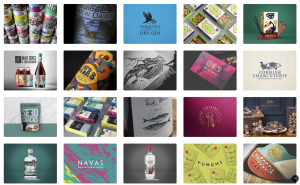 Q. Does being located in Falmouth present challenges to finding work? You seem to have a mix of local and further afield clients – does this present a specific challenge? If so, how do you tackle those challenges?
Q. Does being located in Falmouth present challenges to finding work? You seem to have a mix of local and further afield clients – does this present a specific challenge? If so, how do you tackle those challenges?
A. Initially, we did find it restricted us slightly – simply because the networking opportunities down here are so few and far between. However, as we’ve grown we’ve learnt to use it as a strength and now it really poses no problems. If anything, it works to our advantage – we have an amazing team that always brings their A-game partly because of this lifestyle. Sea swims before work, coastal walks after work, and arguably one of the loveliest commutes in the country – we reckon it’s the future of a successful creative business.
Q. How would you describe your practice? What is the most important element to you? Has lockdown presented any special challenges?
A. This is a tricky one! We see ourselves as a new generation of branding agency for a new generation of brands. This kind of incorporates all aspects of the business, from taking traditional techniques and incorporating them into new trends and designs, to making sure our team are always looked after and everyone’s voices carry the same weight. Because we are so people-centric, I think everyone struggled working remotely during lockdown. We actually reckon we produced some of our best work, but it became very evident quite how collaborative we are and how integral communication as a team, and with clients, is.
Production
 Headland Printers are a local commercial printers offering design, print and finishing. Headland are based in Penzance and have been operating since 1966. Headland specialise in lithography, digital print, large format print, vinyl cutting, sign making, vehicle graphics, print finishing and more. I work in the design studio, both designing directly for clients and helping other designers set files up for print properly. We help a lot of small businesses get established as well as working with local artists a great deal and are active in the community. My favourite projects involve the community, under normal circumstances I design posters, banners, schedules and programmes for art & makers fairs, the Penzance Literary festival, the Golowan Festival and more.
Headland Printers are a local commercial printers offering design, print and finishing. Headland are based in Penzance and have been operating since 1966. Headland specialise in lithography, digital print, large format print, vinyl cutting, sign making, vehicle graphics, print finishing and more. I work in the design studio, both designing directly for clients and helping other designers set files up for print properly. We help a lot of small businesses get established as well as working with local artists a great deal and are active in the community. My favourite projects involve the community, under normal circumstances I design posters, banners, schedules and programmes for art & makers fairs, the Penzance Literary festival, the Golowan Festival and more.
We are also well known for our graffiti wall. 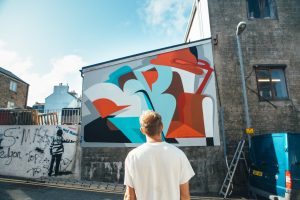 When the outside wall became a target for local taggers, we decided to make it a feature rather than continuing to paint over it. There are now two large stencil pieces on the wall and a mural by Kleiner Shames covering the side of the factory.
When the outside wall became a target for local taggers, we decided to make it a feature rather than continuing to paint over it. There are now two large stencil pieces on the wall and a mural by Kleiner Shames covering the side of the factory.
Headland Printers is located on Bread Street in Penzance, and is not alone in street art. For such a small street set back from the main road, Bread Street is home to a vibrant array of galleries, small shops and artists. The Beehive is a striking multisided corner building holding a gallery, teaching space and a print studio for Catherine Harvey Jefferson, Felicity Robertson, and Julia Mills and is the hub for PZ Studios, a collective of Penzance artists. Bread Street is also the home to the Redwing Gallery, a community funded art charity and cafe offering studio and exhibition space to marginalised artists.
Cornish Laser Cutting Cornish Laser Cutting are an innovative laser cutting business in West Cornwall. They design, laser cut and finish anything from signage to artwork to awards. They have been doing engaging signage for a lot of local businesses and are working on a workshop/ice cream shop/gallery space at the Old Wayside Museum in Zennor with the Moomaid of Zennor. From their website –
Cornish Laser Cutting are an innovative laser cutting business in West Cornwall. They design, laser cut and finish anything from signage to artwork to awards. They have been doing engaging signage for a lot of local businesses and are working on a workshop/ice cream shop/gallery space at the Old Wayside Museum in Zennor with the Moomaid of Zennor. From their website –
“Our family business was founded in 2017 in the far west of Cornwall. 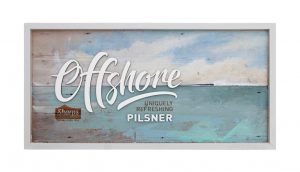 We artfully combine laser cutting technology with hands-on techniques to design & create beautiful, bespoke products. From eye-catching signage to tactile, original merchandise that showcases your brands’ image with our distinct style.
We artfully combine laser cutting technology with hands-on techniques to design & create beautiful, bespoke products. From eye-catching signage to tactile, original merchandise that showcases your brands’ image with our distinct style.
We cut and engrave logos, graphics, artwork and patterns. We creatively layer, emboss, resin, dye, paint, inlay, burn and blend. Ours is not disposable mass production but individually crafted items that are imbued with tactility & beauty, designed to be cherished for the long haul.
Our coastal workshop in Zennor runs on 100% renewable electricity. We opt for natural, reclaimed & recyclable materials. The nature of our work allows us to utilise even the smallest offcuts and leftover product, ensuring the minimum of waste.”
They don’t just cut things with lasers. The combination of woodworking techniques, painting, layering and finishing creates very special work with a definite Cornish sensibility. I would love to collaborate with them some day – creating objects, and not just graphic assets, is very rewarding for me.
Blackwater Studios are a screenprinters near Truro. While they mainly focus on tshirt printing, they work with a vibrant group of artists and illustrators as well as groups like Surfers Against Sewage and strive to be environmentally friendly, only using solvent free water based inks.
Since 2017 Blackwater has collaborated with designers and illustrators to produce seasonal printed boxes, rather than send their products out in plain packaging. They also publish spotlights and interviews with their artists on their blog.
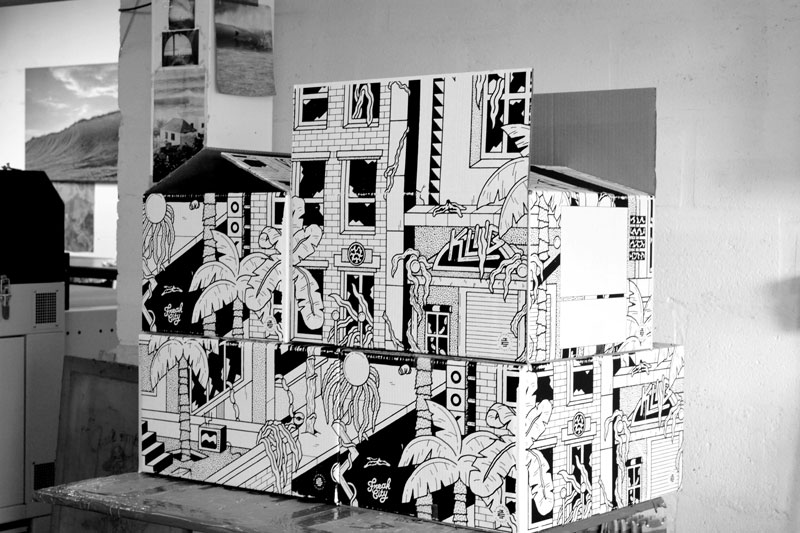
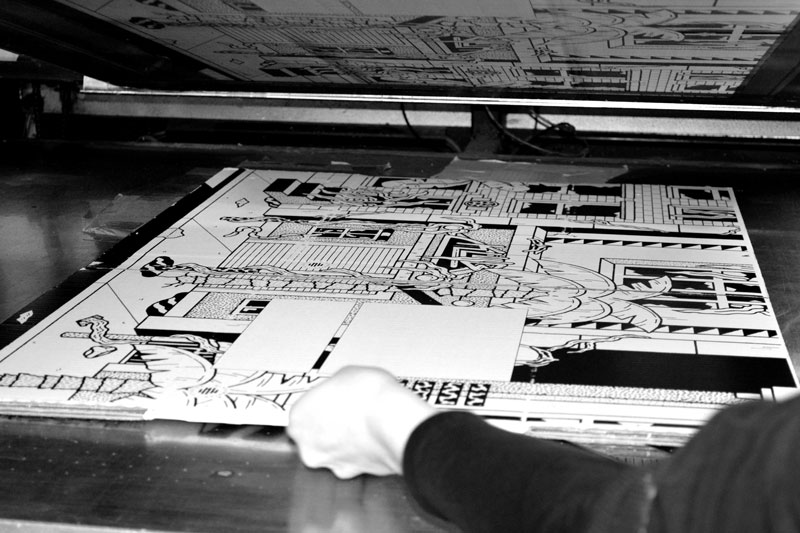
Reflection
This task was incredibly worthwhile. I discovered some new practioners, while also finding out more about those I was already familiar with. Two of the studios were happy to answer my questions, and I managed to reconnect with an old colleague I hadn’t seen for many years. It can be very easy to stay comfortable with what you already know about what is around you. Shaking that complacency off and engaging with what is around you can lead to new connections and opportunities that would have otherwise been missed.
Looking a bit beyond what I was already aware of in my local area, I found far more than I could spotlight in my work this week. I have also enjoyed exploring the areas my cohort have added to the geotagging map.
I would love to collaborate more with artists, or spend some time doing printmaking workshops. This week has led me to more resources and inspiration. For being small and isolated, Cornwall has an incredibly rich art and design past, and it is impossible not be be inspired by the stunning scenery here. The rugged coasts, beautiful beaches, peaceful sand dunes, stompy walks through the moors and woodlands, what more could you ask for?
References
BLACKWATER STUDIOS. 2019. “Welcome to Blackwater Studios | Screen Printing.” Blackwater Studios [online]. Available at: https://blackwaterstudios.co.uk/ [accessed 13 Oct 2020].
CHODOWIECKI, Daniel. n.d. 62 Previously Unpublished Hand Drawings for the Elementary Work by Johann Bernhard Basedow. With a Foreword by Max von Boehn. Voigtländer-Tetzner, Frankfurt Am Main 1922. Available at: https://en.wikipedia.org/wiki/Printing_press#/media/File:Chodowiecki_Basedow_Tafel_21_c_Z.jpg.
Copyright “The Jon Wood Collection.” 1958. 4553 and 4554 on the 9-20 St Ives to Paddington.
CORNISH LASEER CUTTING. 2020. “Laser Cutting Cornwall. Hand Crafted, Laser Cut Gifts, Signs & Products.” The Cornish Laser Cutting Co. [online]. Available at: https://cornishlasercutting.co.uk/ [accessed 13 Oct 2020].
EDWARDS, Susanna and RAEIN, Maizar. 2020. Week 2 [lecture]. GDE710 for MA Graphic Design. Falmouth: Falmouth University 2020 [Accessed 13 Oct 2020]
EIGHT WIRE. 2017. “Eight Wire | Full Service Creative Marketing Agency Based in Falmouth.” Eight Wire [online]. Available at: https://eightwire.uk/ [accessed 13 Oct 2020].
HEADLAND PRINTERS. 2015. “Headland Printers.” Headland Printers [online]. Available at: http://www.headlandprinters.co.uk/ [accessed 13 Oct 2020].
KINGDOM & SPARROW. 2020a. “Kingdom & Sparrow | Creative Design & Branding Agency.” Kingdom & Sparrow [online]. Available at: https://www.kingdomandsparrow.co.uk/ [accessed 13 Oct 2020].
KINGDOM & SPARROW. 2020b. Old Art School Falmouth. Kingdomandsparrow.co.uk. Available at: https://www.kingdomandsparrow.co.uk/wp-content/uploads/2019/07/Old-art-school-Falmouth.jpg [accessed 13 Oct 2020].
KLEINER SHAMES. 2019. “KLEINER SHAMES.” Kleiner Shames [online]. Available at: https://www.kleinershames.com/ [accessed 13 Oct 2020].
NIXON DESIGN. 2020. “Nixon Design.” Nixon Design [online]. Available at: https://www.nixondesign.com/ [accessed 13 Oct 2020].
Trustees of the British Museum. n.d. Cuneiform Tablet. Available at: https://www.khanacademy.org/humanities/ancient-art-civilizations/ancient-near-east1/the-ancient-near-east-an-introduction/a/cuneiform [accessed 29 Nov 2020].
